|
KIMBERLEY TOAD BUSTERS NEWSLETTER
53:
24/01/2014
The Cane Toad is a Key Threatening Process to the Australian Nation
Declared by the Federal Government 12 April 2005
2013 United Nations Finalist as well as finalist in 7 other state, national and
international awards since 2006.
Prepared by Jordy Groffen–Researcher at Kimberley Toad Busters.
The Kimberley Toad Busters’ Newsletter is produced by Kimberley Specialists In Research
Inc in conjunction with Kimberley Toad Busters Inc. Kimberley Specialists, a founding
member of the Kimberley Toad Busters, continues to support the campaign against the cane toad by supporting www.canetoads.com.au raising funds and supporting cane toad scientific research.
KTBs are a tax deductible charitable entity. Please see our website for our direct donation
facility, or ways in which you can sponsor community toad busting efforts or one of our
research or educational projects.
IF EVERYONE WAS A TOADBUSTER, THE TOADS WOULD BE BUSTED!
kimberleytoadsbusters@canetoads.com.au
www.kimberleyspecialists.com.au
kimberleyspecialists@westnet.com.au
Contents
A toad race as “fund raise”!
The importance of toad control
A toad race as “fund raiser”!
While the Western Australian government decided not to give the KTB community group more funding and to let the toads freely invade the rest of the Kimberley, the community group, with the help of the Kununurra Kimberley Grande, is not prepared to give up the cane toad fight so easily.
On Australia Day a toad event will be held to raise funds for KTB. Cane toads in Kununurra are in for the surprise of their lives. The Kimberley Grande has organised a cane toad racing event at their venue in Kununurra on the 26th of January. Participants can bring their own trained toad and join the races or buy one at the race course. The entry per heat is $10 with all the money raised from this fundraising event to go to the Kimberley Toad Busters and their great community efforts. There will be a free sausage sizzle from 2.00pm and the first round of races will start from 3.00pm. Participants racing toads will need to be there to register before the start of the races. The Kimberley Grande will also provide a great prize of $500 for the owner of the winning toad of the final race! |
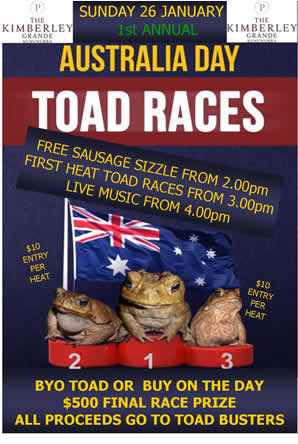 |
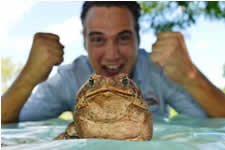 |
“This event is a great educational way to show another side of the cane toads, something different, not only negative but also great fun!” commented Lee Scott-Virtue founder and President of KTB. Lee continued “Jordy is already training some toads and he thinks he has a good chance to win, however I am not sure if Killer Katie (that is what he named his 15cm giant female toad) is quick enough to beat the much smaller males”.
Hope to see you all in the Kimberley Grande on Sunday 26 of January. |
Ps: Steroids or other drugs are not allowed in the contestants, a local vet will perform drug tests before toads enter the arena. KIDDING!
The importance of toad control
The cane toads crossed into WA in February 2009 and reached Kununurra in the early year of 2010, and have been there for almost 4 years. Lee Scott-Virtue, President & Founder of KTB commented that “Although the cane toad has a devastating impact on the wildlife in and around Kununurra there are multiple toad controlled areas where the impact on the wildlife is remarkably less, thanks to community efforts”.
Jordy Groffen Animal Scientist at KTB stated “KTB has controlled the cane toad population level from the first arrival in the area around the KTB headquarters, not always an easy task with thousands of toads removed over the years, but the effort has been worth it!”
Before the toad invasion, a good population of blue tongued lizards, pythons, yellow spotted monitors and even the odd merten’s monitor frequented the area around the KTB headquarters. “These species and especially the varanid lizard and the blue tongued are highly impacted. In some uncontrolled areas you get a 100% loss of blue tongued lizards and a 70%-97% loss of bigger varanid lizards” stated Jordy Groffen, KTB researcher and Animal Scientist. He added that “four years after the toad invasion we still see lots of the same blue tongued lizards, which we recognize because they were stealing our eggs out of the chook pen and often missing a part of their leg”. The population of varanid lizards have |
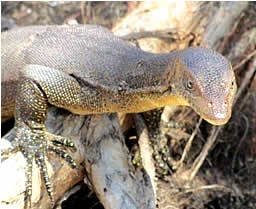 |
| One of the surviving Merten’s Water Monitors |
|
gone down, also in our controlled toad area around the headquarters. However, there are still a couple of survivors around and if they have survived 4 years of cane toads they now know to avoid this toxic meal. “Even better news is that we have recently spotted a couple of young yellow spotted monitors, which means that they know to avoid the cane toad as well and that in time we may actually begin to see an increase in the population around KTB headquarters” stated Dean Goodgame ,co-founder of KTB.
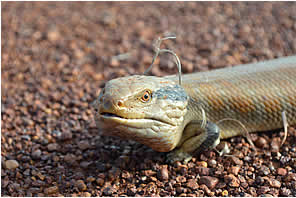 |
| One of the surviving egg eating Blue tongued lizards around the HQ |
|
The work of the Kimberley Community group Kimberley Toad Busters has clearly shown that by controlling cane toad population numbers in a given area you minimise the chance of native predators attacking and consuming a toad, which in turn reduces the number of native animals dying from the direct impact of the cane toad. Keeping toad numbers under control also helps the smaller insect eating native predators such as frogs, smaller skinks and lizards by reducing food competition. With cane toads capable of eating around 200 insects a night, uncontrolled numbers of cane toads increases food competition very quickly. Jordy Groffen added. “By reducing the food competition a larger number of the smaller native animals stay alive, which in turn provide a healthy meal for the bigger native predators. Even if the bigger native predator has learned to avoid the toxic cane toad in times when the food supply is low they are known to still try to consume a cane toad and often with a negative ending for both toad and native predator”. |
Zigourney Nielsen, Bachelor of Biological Sciences and volunteer research assistant at KTB, stated “In some areas the cane toad density is so high that I couldn’t believe that there was any other wildlife around”. Zigourney continued “You clearly see the difference between a cane toad controlled area and a non-controlled area. While we only saw some birds and skinks in the non-controlled area we saw two pythons, a Blue tongue and Bandicoots in the controlled area”.
A really important aspect of cane toad population control is the removal of toad eggs from aquatic systems. The toad eggs are laid in high numbers, between 30.000 and 35.000 eggs twice a year, and are much more toxic than the toad tadpole or metamorph stages. It has been shown that almost every native frog tadpole dies after consuming toad eggs, with some frog species showing a mortality rate of up to 90%. Some fish species and other aquatic animals also die when in contact with toad eggs. The eggs are not dangerous for humans to touch and are easily removed either by hand or with very fine meshed nets. If handled carefully you can pull the whole string of toad eggs out of the water and potentially remove 35.000 deadly threats to the native wildlife.
Cane toads eggs are laid in long strings, while frogs lay their eggs in clusters. For more information on identification and removal of any phase of the cane toad life cycle, please visit our website www.canetoads.com.au or email us on kimberleytoadbusters@canetoads.com.au |
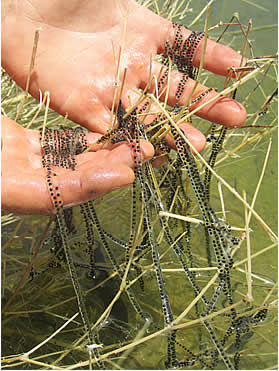 |
| Long strings of cane toad eggs |
|
Don’t forget to “Like” us on Facebook and Follow us on Twitter!
For further information contact
Jordy Groffen: 08 91682576
Lee Scott-Virtue: 08 91687080
If everyone became a toad buster.
The toads would be busted!

Kimberley Toad Busters awards!
For more information on any of the articles contact:
Lee Scott-Virtue: KTB Founder & President 08 9168 7080 kimberleytoadbusters@canetoads.com.au
All donations are tax deductible.
Sponsors


|





